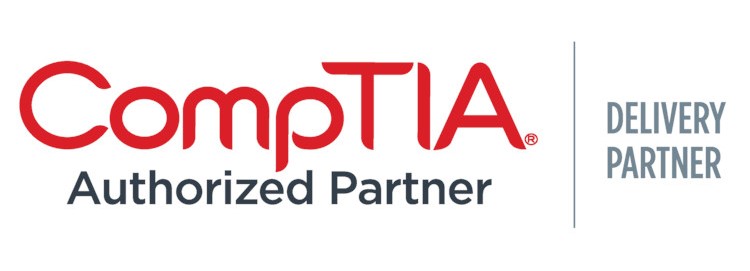
- Description
- Objectives
- Outline
- Materials
- Certification
- System Requirements
- Watch a Demo
Computer networks are crucial in almost every organization. Network administrators are responsible for the day-to-day operation of these networks. They organize, install, and support an organization’s computer systems, local area networks (LANs), wide area networks (WANs), network segments, intranets, and other data communication systems as necessary.
CompTIA A+
We offer you the most effective way to earn your CompTIA A+ certification. CompTIA A+ is the starting point for a career in IT. The exam covers maintenance of PCs, mobile devices, laptops, operating systems and printers. Two exams are necessary to be certified: exam 220-1201 and 220-1202.
CompTIA A+ 220-1201 covers the fundamentals of computer technology, installation and configuration of PCs, laptops, mobile devices and related hardware, and basic networking. CompTIA A+ 220-1202 covers the skills required to install and configure PC operating systems, security, as well as software troubleshooting.
Recommended Experience: Students should have basic keyboarding and computer skills, and be comfortable navigating the internet.
Recommended Experience: 9 to 12 months hands-on experience in the lab or field
CompTIA Authorized Partner ID: 1298427

Cisco Certified Network Associate (200-301 CCNA) Part 1
This CCNA 200-301 Part 1 course prepares you for the exam associated with the Cisco Certified Network Associate certification. This course provides the knowledge and skills required to successfully install, operate, and troubleshoot a small to medium size enterprise branch network. This course covers topics such as networking, switch management, configuring IPv4 and IPv6 networks, LANs, VLANs, and more.
This course includes access to a hands-on Practice-Lab for 200-301, which will allow candidates to have training in the practical application of the course concepts without having to buy any additional software and will prepare them for success on the certification exam.
Prerequisite(s): Students should have keyboarding and computer skills, and be comfortable navigating the internet.
Cisco Certified Network Associate (200-301 CCNA) Part 2
This CCNA 200-301 Part 2 course, in conjunction with Part 1, prepares you for the exam associated with the Cisco Certified Network Associate certification. This course introduces topics that will help you build an enterprise network so that devices connect and communicate with others. We discuss aspects of IPv4 access control lists (ACLs), security threats and vulnerabilities, IP services, network architecture, and network automation.
This course includes access to a hands-on Practice-Lab for 200-301, which will allow candidates to have training in the practical application of the course concepts without having to buy any additional software and will prepare them for success on the certification exam.
Prerequisite(s): Cisco Certified Network Associate (200-301 CCNA) Part 1
** Course Subject to Change.
CompTIA A+
By the end of this course, you will be able to:
- Identify the basics of PC hardware, configuration and wireless networks
- Recall the steps for troubleshooting hardware, including mobile devices, printers and networking
- Recognize the steps for installing and configuring operating systems and software
- List ways to work with network services and operational procedures
- Identify security concepts and technologies
Cisco Certified Network Associate (200-301 CCNA) Part 1
By the end of this course, you will be able to:
- List the steps for small network implementation and security
- Recall how to implement LANs, VLANs, and STP
- Identify and be able to configure IPv4 routing protocols
- Recognize the concepts behind IPv6
- Identify troubleshooting basics
Cisco Certified Network Associate (200-301 CCNA) Part 2
By the end of this course, you will be able to:
- List concepts of IPv4 access control lists
- Recall topics associated with security threats, vulnerabilities, and exploits
- Identify aspects of IP services
- Recognize the fundamentals of LAN, WAN, and cloud architecture
- Describe details for network automation
CompTIA A+
CompTIA A+ 220-1201 Module 1
PC Hardware
- Motherboards, Processors, and Memory
- Identifying Motherboard Components
- Purposes of Processors
- Memory Terms
- Cooling Systems
- Installing and Configuring Expansion Cards
- Understanding Storage Devices
- Understanding Power Supplies
CompTIA A+ 220-1201 Module 2
Peripherals, Cables, Connectors and Mobile Hardware
- Peripherals and Expansions
- Connectors and Cables
- Working with Laptop and Mobile Devices
- Disassembling and Reassembling Laptops
- Batteries and Power Adapters
CompTIA A+ 220-1201 Module 3
Printers and Networking Fundamentals
- Understanding Print Technologies
- Imaging Processes
- Installing and Maintaining Printers
- Networking Principles
- Identifying Common Network Hardware
CompTIA A+ 220-1201 Module 4
TCP/IP and Network Services
- TCP/IP Structure
- Internet Layer Protocols
- Understanding IP Addressing
- Understanding Network Services
- DNS Server
- Syslog Clients
CompTIA A+ 220-1201 Module 5
Wireless and SOHO Networking and Mobile Connectivity
- Understanding Wireless Networking Technologies
- Installing and Configuring SOHO Networks
- Mobile Connectivity
- Mobile App Support
- Cellular Data Connections
CompTIA A+ 220-1201 Module 6
Cloud Computing and Troubleshooting
- Virtualization
- Cloud Computing
- Troubleshooting Best Practices
- Motherboards, RAM, CPUs, and Power Problems
- Troubleshooting Video, Projector, and Display Issues
- Troubleshooting Common Mobile Device Issues
Outline: A+ 220-1202
CompTIA A+ 220-1202 Module 7
Operating System Administration
- Understanding Operating Systems
- Understanding Applications
- Introduction to Windows
- Windows Configuration
- Windows Registry
- Disk Management
CompTIA A+ 220-1202 Module 8
Windows, macOS and Linux
- Installing and Upgrading Windows
- Command-Line Tools
- Networking in Windows
- MacOS and Linux
- Applications on macOS
- Best Practices
- Basic Linux Commands
CompTIA A+ 220-1202 Module 9
Security Concepts
- Physical Security Concepts
- Logical Security
- Malware
- Mitigating Software Threats
- Social Engineering Attacks, Threats, and Vulnerabilities
- Exploits and Vulnerabilities
- Windows OS Security Settings
- Web Browser
- SOHO Network Wireless and Wired
- Mobile Device Security
CompTIA A+ 220-1202 Module 10
Troubleshooting Operating Systems and Scripting
- Troubleshooting Common Microsoft Windows OS Problems
- Troubleshooting Security Issues
- Best Practices for Malware Removal
- Mobile OS Issues
- Scripting
- Remote Access
CompTIA A+ 220-1202 Module 11
Safety Concerns and Documentation
- Understanding Safety Procedures
- Understanding Environmental Controls
- Understanding Policies, Licensing, and Privacy
- Documentation and Professionalism
- Change Management Best Practices
- Backup and Recovery
- Disaster Prevention and Recovery
- Demonstrating Professionalism
**Outlines are subject to change, as courses and materials are updated.**
Cisco Certified Network Associate (200-301 CCNA) Part 1
**Outlines are subject to change, as courses and materials are updated.**
Cisco Certified Network Associate (200-301 CCNA) Part 2
**Outlines are subject to change, as courses and materials are updated.**
Ed4Career is committed to being both environmentally conscious and making it easier for you to study! We’re making your education mobile! All of our textbooks are now provided as eTextbooks*. You can access them on your laptop, tablet, or mobile device and can study anytime, anywhere.
The move away from physical books to eTextbooks means you get the latest, most up-to-date version available. This also makes your training more accessible, so you can study anywhere you have your phone or tablet. The best part is that all materials are included in your training cost so there are NO extra fees for books!**
*A few courses still have physical materials.
CompTIA A+
Upon successful completion of this course, students will be prepared, in part, to sit for the CompTIA A+ 220-1201 & 220-1202 certification exams.
Cisco Certified Network Associate (200-301 CCNA) Part 1
Upon successful completion of CCNA Part 1 and CCNA Part 2 courses, students will be prepared, in part, to sit for the Cisco Certified Network Associate Exam 200 – 301 CCNA certification exam.
Cisco Certified Network Associate (200-301 CCNA) Part 2
Upon successful completion of this course and Cisco Certified Network Associate (200-301 CCNA) Part 2, you will be prepared, in part, to sit for the Cisco Certified Network Associate Exam 200 – 301 CCNA certification exam.
** Certification exams are not included in the cost of the course.**
Internet Connection
- Broadband or High-Speed - DSL, Cable, and Wireless Connections
*Dial-Up internet connections will result in a diminished online experience. Classroom pages may load slowly and viewing large audio and video files may not be possible.
Hardware Requirements
- Processor - 2GHz Processor or Higher
- Memory - 1 GB RAM Minimum Recommended
PC Software Requirements
- Operating Systems - Windows 7 or higher
- Microsoft Office 2013 or higher. Also, you could use a general Word Processing application to save and open Microsoft Office formats (.doc, .docx, .xls, .xlsx, .ppt, .pptx)
- Internet Browsers - Google Chrome is highly recommended
- Cookies MUST be enabled
- Pop-ups MUST be allowed (Pop-up Blocker disabled)
- The Kindle Reader App or VitalSource Bookshelf App are needed for many of our courses (No special equipment needed. This can be downloaded for FREE onto your computer.)
- PowerPoint Viewer (if you do not have PowerPoint)
- Adobe PDF Reader
- QuickTime, Windows Media Player &/or Real Player
MAC Software Requirements
- Operating Systems - Mac OS x 10 or higher with Windows
- Mac office programs or a Word Processing application to save and open Microsoft Office formats (.doc, .docx, .xls, .xlsx, .ppt, .pptx)
- Internet Browsers- Google Chrome is highly recommended
- Cookies MUST be enabled
- Pop-ups MUST be allowed (Pop-up Blocker disabled)
- The Kindle Reader App or VitalSource Bookshelf App are needed for many of our courses (No special equipment needed. This can be downloaded for FREE onto your computer.)
- PowerPoint Viewer (if you do not have PowerPoint)
- Adobe PDF Reader
- Apple QuickTime Media Player


